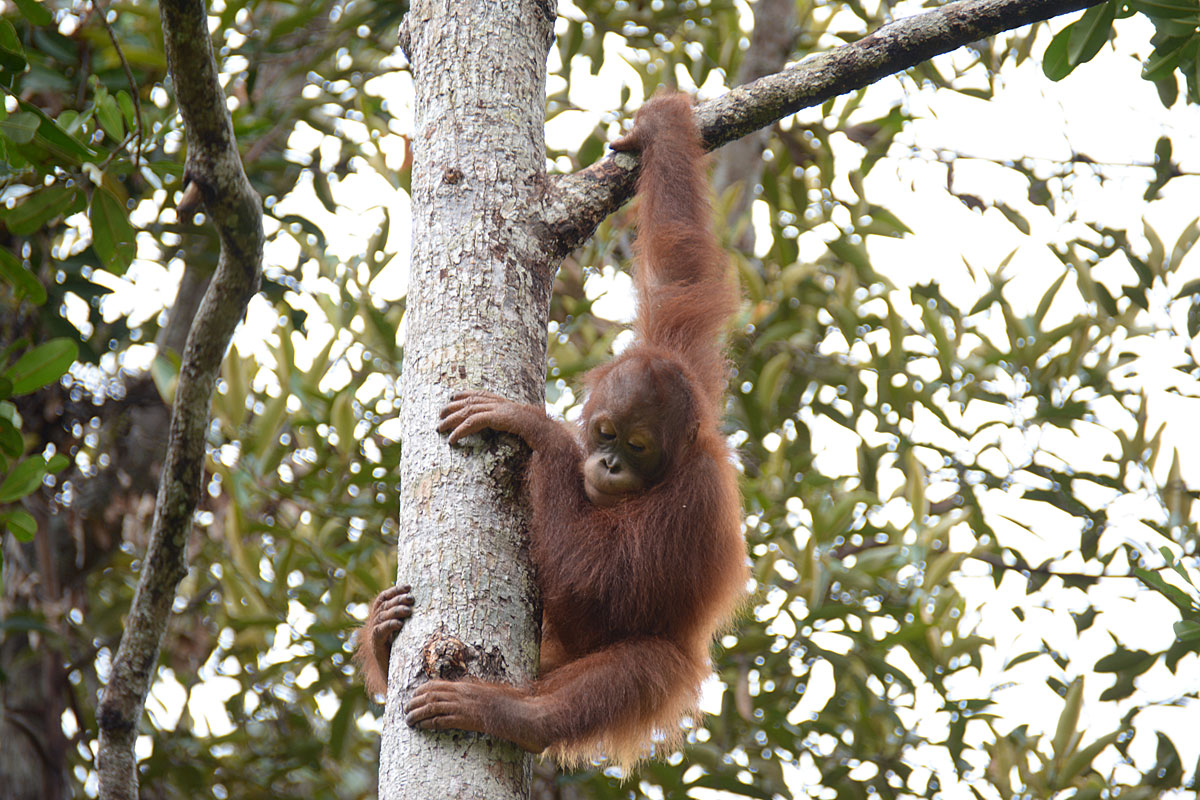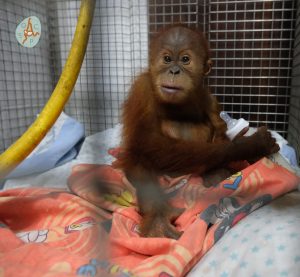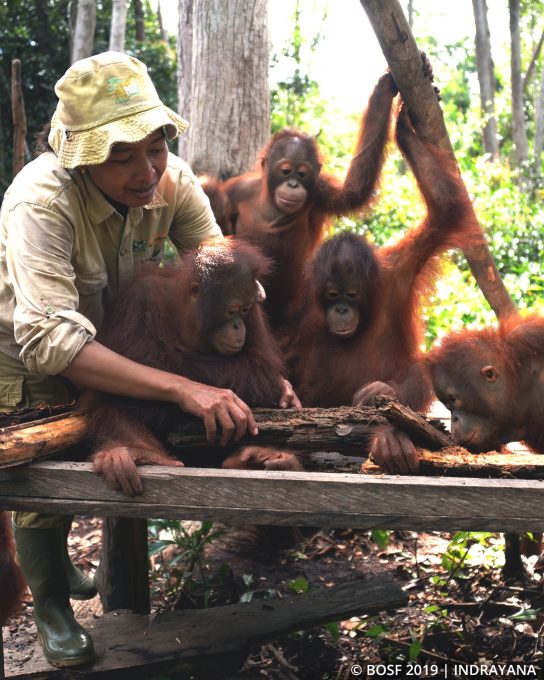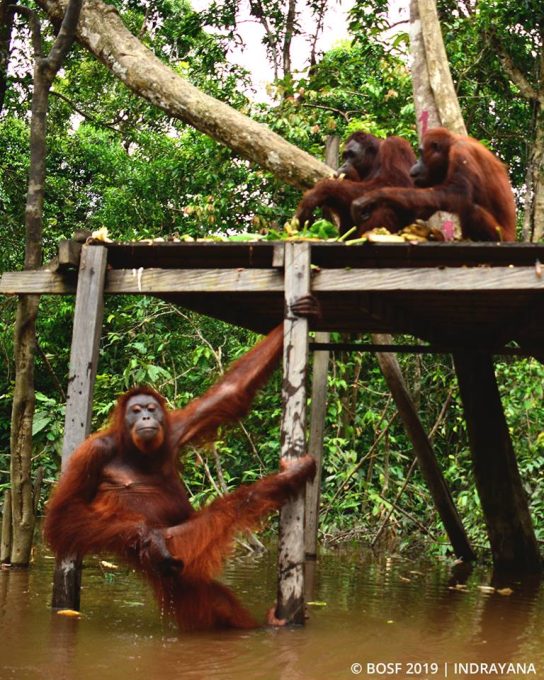Rehabilitation

REHABILITATION – The Second "R" of "Red Ape Relief"
Orangutans who are rescued and are in need of care are taken to orangutan rehabilitation centers. Our partners that manage such centers include: Borneo Orangutan Survival Foundation (BOSF); International Animal Rescue Indonesia (YIARI) and the Sumatran Orangutan Conservation Program (SOCP). The goal for each orangutan brought to a rehabilitation center is that it will one day return to live freely in the forest. Orangutans are critically endangered, so each individual's genetic blueprint is vital for the future survival of the species. Therefore, it is absolutely crucial that orangutans have a chance to live wild in the forest, where they can continue to have offspring and ensure their survival as a species. At orangutan rehabilitation centers in Borneo and Sumatra, rescued orangutans are gently helped to prepare for life in the wild. Orangutan Outreach is proud to provide funding for the operation of these centers.
 Arrival at the center
Arrival at the center
Orangutans are brought to rescue centers in the province from which the orangutan originated. This is often the province from which they are rescued, but if an orangutan has been smuggled out of the country, a DNA test will confirm its origin. Sumatran orangutans are not mixed with Bornean orangutans, nor are subspecies mixed together. After rehabilitation, it is vital to get the orangutans back in the correct forest where they belong.
Rescued orangutans are brought to centers where veterinarians examine the apes to evaluate their current health and medical needs. In the center they are tested for diseases while kept in quarantine for several months. The orangutans are given a name immediately which helps for the record keeping that is done for each individual. Many of the confiscated orangutans are in very poor physical condition. They are malnourished and often suffer from various diseases, often caught as a result of contact with their human abductors. Therefore it is absolutely crucial that the new arrivals do not mix with the other orangutans in the center. Both small and large quarantine cages are used for these new arrivals. After the orangutans have been examined and are deemed healthy, they are placed in existing groups depending on their age and skills.
 Group Placement and Forest School
Group Placement and Forest School
Preparing for life in the wild can be a long process. Baby orangutans normally live with their mother for the first six to eight years of their life - until they are strong enough to cope on their own. It takes years to teach the little ones the skills they will need to become independent, wild orangutans. In a rehabilitation center, human caregivers must teach the babies the skills that their mother would have. This is referred to as rehabilitation. The orangutans must learn that they are not pets, they are wild animals.
Just like humans, the first years of an orangutan's life are very important for their future development. Orangutans younger than 2 years are placed in the nursery where they have around the clock care. The infants are fed milk from a bottle to start with and are then slowly taught to eat different kinds of fruit. These precious babies are taught basic skills such as climbing small trees. It is a special time when the babies begin to make friends and find comfort with each other.
The larger orangutans are carefully evaluated before deciding where to place them. As a general rule they will be placed in socialization cages where they live together with 10-15 other orangutans. Most confiscated orangutans have been brought up chained to something in order to restrict their movements, and they have also been living with humans as their only companions. It is therefore imperative for these apes to get to know other orangutans and create a social network before being released into the wild.
Orangutans move from the nursery to baby school and then to various levels of forest school. Each day the orangutans are brought deep into the forest on the grounds of the center to have lessons. Lessons include: tree climbing; what is safe to eat; how to build a strong nest; and what poses a threat to safety. The orangutans are patiently taught and carefully observed by trained staff. They are observed when climbing, eating, and playing. Log books are kept for each individual and the apes are evaluated on their progress. Some orangutans will advance quickly through the stages of forest school, while others need more time to learn skills. There is no set time frame but most orangutans who arrive as infants will spend 8-10 years going through the rehabilitation process.
 Perfecting Skills
Perfecting Skills
Once an orangutan has “graduated” from forest school, they are placed on an island to live with other orangutans. On these islands, the apes have less contact with their human caregivers but are still carefully monitored. The orangutans receive supplemental feedings but are generally foraging for food on their own. The orangutans can choose where and how to spend their days, and they make a nest to sleep in each night. On the islands, the orangutans can live a life that is very close to life in the wild. Orangutans will spend one or more years on the island perfecting their survival skills.
After successfully completing rehabilitation, the orangutans are ready for the next step. This is an exciting "R" of orangutan conservation - Releases!
Release back to freedom in the rainforest is always the goal. However, there are some orangutans who are not able to learn necessary skills during rehabilitation. These orangutans may be blind, injured, or suffering from serious illness. Some of the sweet souls were in captivity far too long to ever learn how to be an orangutan. If an orangutan cannot be released, they are moved to a life of Retirement.
The 5 Rs of Red Ape Relief
Rescues
Rehabilitation (back to the top)
Releases
Retirement
Reforestation
